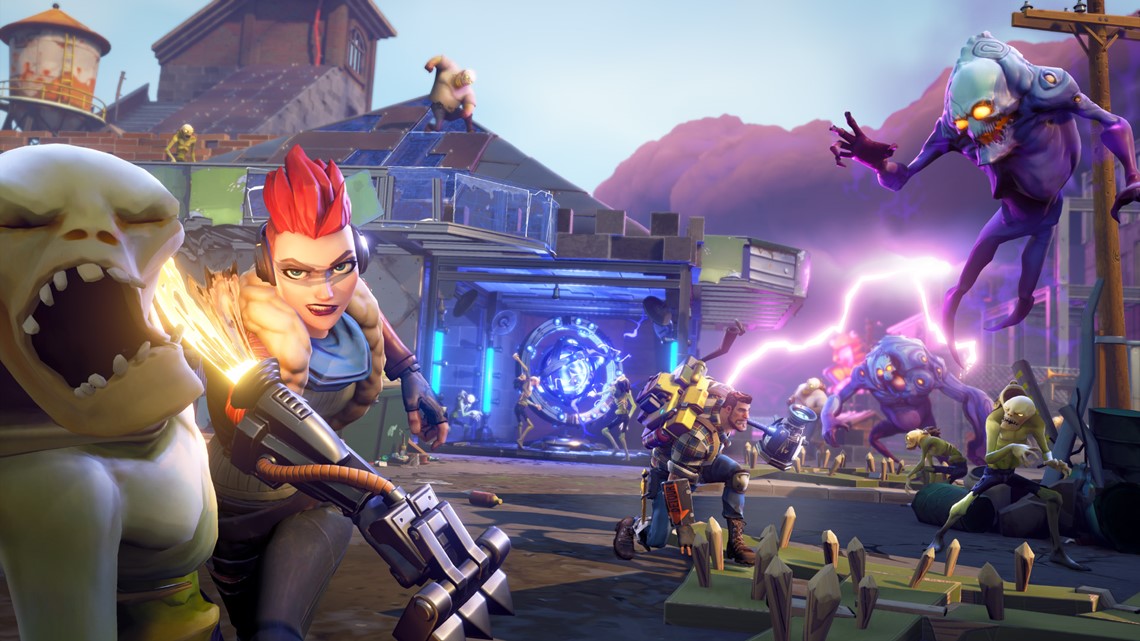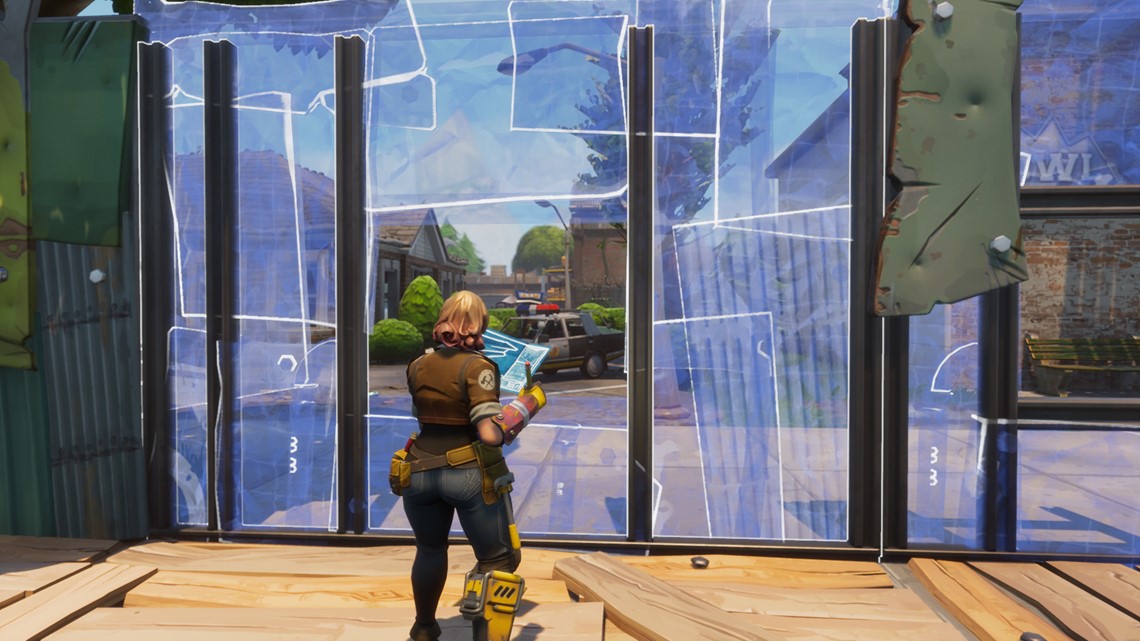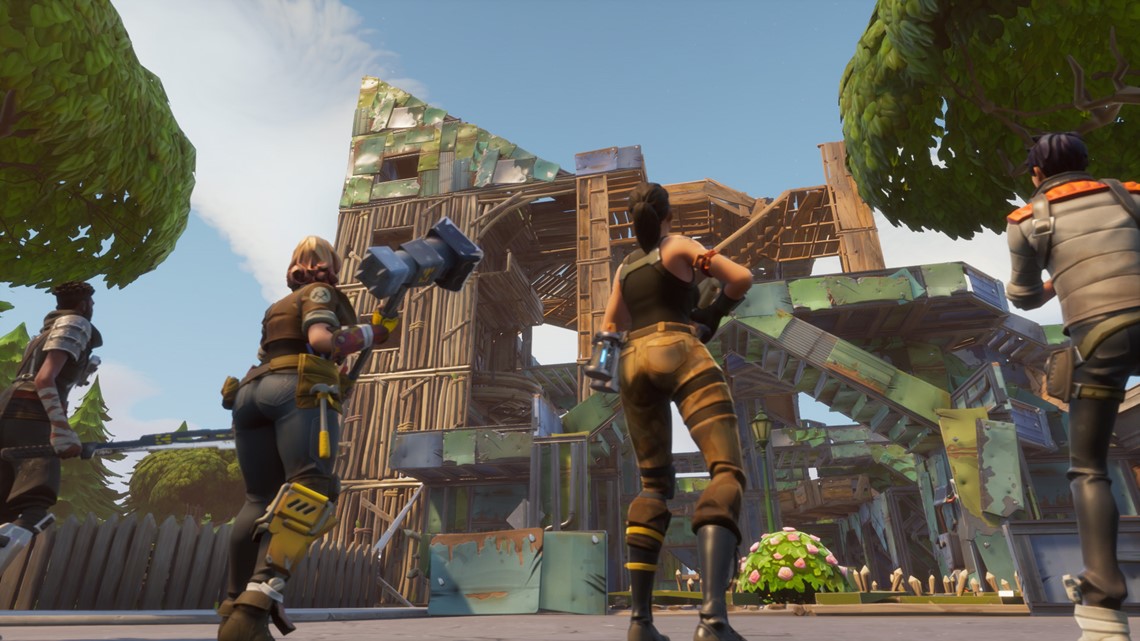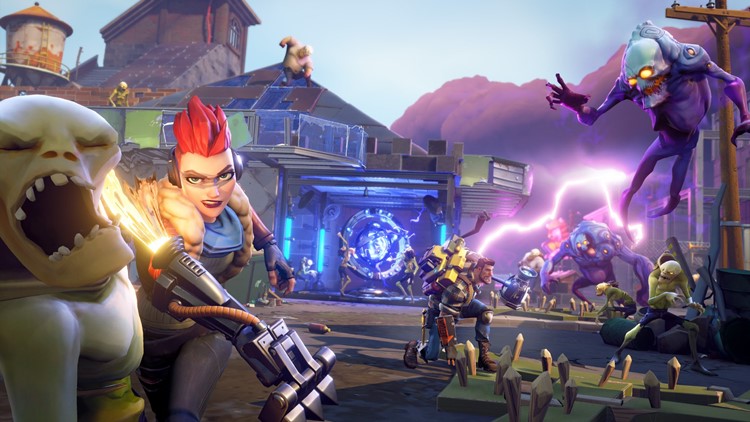

- reviewed on PlayStation 4 / rated T / starts at $39.99 / released July 2017
- OFFICIAL SITE: Epic Games
- PURCHASE LINK: Epic Games
- FINAL: You WANT this game. 4 out of 5 stars
“Fortnite” probably has too much going on. It’s a squad-based cooperative shooter. It’s a tower defense game. It has resource management, loot boxes and a card collecting angle. “Fortnite” is off-puttingly dense, dumping the player inside complicated menus and systems… but it’s also really fun once you actually get to play it. There’s a wild experience in “Fortnite” – unlike just about anything else out there – but it’s a balancing act that asks a lot in return.
The shorthand setup for “Fortnite” is “zombie apocalypse.” However, “Fortnite” unexpectedly opts for a soft, silly look, rather than the usual bloody shamblers. The world is all crooked angles and bright colors straight out of a 1950s childrens’ book, and the undead enemies look like they escaped from a “Ninja Turtles” episode. It’s nice to see an overdone concept redrawn with a distinctive visual design.
And “Fortnite” is a distinctive game. Each timed round consists of two phases. For the first half, you (and up to three other online players) explore a small zone, typically a mix of forest/residential/city environments. Your unbreakable pickaxe lets you demolish just about anything, breaking down cars, walls and refrigerators into building components like bricks, twine and bacon. These elements are used to craft traps, ammunition and defenses for the second half of the match when the zombies attack.
Zombies arrive in waves, teleporting in near mysterious alien tendrils and mindlessly flooding towards whatever McGuffin they’re supposed to destroy. Your team must fend them off, using a combination of guns, special attacks, and, most intriguingly, impromptu buildings and mazes littered with traps.
In addition to everything else going on – collecting resources, crafting ammo, locating goals, saving survivors – you can build structures using the materials you’ve accumulated. You place walls and floors right on the map, adding on to existing homes if you want, constructing entirely new defenses if you do not. The point is to build protection against the horde, with an eye towards funneling their numbers into the traps that you have installed. Assuming you have the components and the blueprints (yes, there’s yet another layer of complication), you can drop in electric shock devices, spike launchers and other death traps intended to thin out the zombie mob.


Surviving the onslaught will net you experience points and new gear so you can improve your skills and tackle more difficult levels. You also collect human survivors (presented almost like trading cards) that can be fitted into job slots that buff up your character or your base, and every one of them can be upgraded using another set of experience points, which is not to be confused with the third kind of experience points that are used to improve weapons and traps.
It’s overwhelming. Even after hours and hours of play, when “Fortnite” tells me that my weapon is broken, I don’t know if I’m supposed to dig through menu after menu to try to repair it, or if I’m supposed to just switch to another weapon. The entire thing is so ponderous, and the tutorial section covers so little, that I have largely just muddled through, ignoring much of the game’s deep structure and only figuring out a little of it at a time.
The hope is that you’ll really dive into those systems to maximize your character’s abilities and progress further into the world of “Fortnite.” Players who really dig micro-managerial elements – like harvesting and stockpiling resources, or building just the right collection of sidekick human cards – will find a lot to chew on between rounds in “Fortnite.”
Eventually “Fortnite” starts making sense, but the complex overlay presents a rough first impression if you’re booting it up in hopes of just running around and shooting zombies.
But you can’t have one without the other, which speaks to the game’s lovely balancing act. The busywork makes sure you’re prepared for the next fight, which yields more useful trinkets and gimmicks for your next planning session. Because the thing is: “Fortnite” is a lot of fun. Being able to construct defenses gives you plenty of creative freedom, and the variety and intensity of the zombie rush really piles on the pressure to survive. A round of “Fortnite” is much more than just the usual monster-shooting arena battle. It’s a mix of exploration, construction and combat that opens up the genre to players who are looking for something fresh.


One final note: while “Fortnite” currently sells for $40 (or more, depending on what upgraded bundle features you want to add), the game will become free to play sometime next year. The developers are calling this “early access,” meaning that they’re still aggressively working on the game behind the scenes. They are changing things, adding content, and essentially using players to stress-test the entire product, but in trade you get the full game now rather than presumably having to buy it in segments and microtransactions later. The key is that “Fortnite” does not feel unfinished or glitchy. This already feels like a polished (if complicated) release and this “early access” is not so early in development that the game barely works or has significant missing pieces.
“Fortnite” is available for PlayStation 4, Xbox One, Mac OSX and Windows. This review is based on product supplied by the developer. Images courtesy Epic Games.



